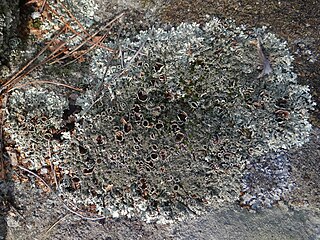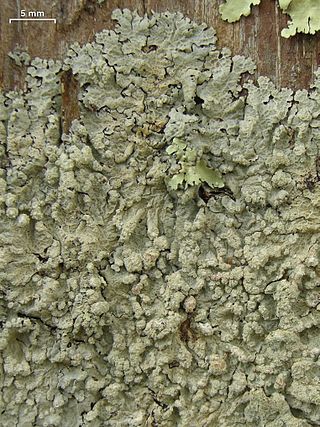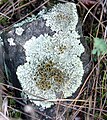
Parmelia is a genus of medium to large foliose (leafy) lichens. It has a global distribution, extending from the Arctic to the Antarctic continent but concentrated in temperate regions. There are about 40 species in Parmelia. In recent decades, the once large genus Parmelia has been divided into a number of smaller genera according to thallus morphology and phylogenetic relatedness.

The Parmeliaceae is a large and diverse family of Lecanoromycetes. With over 2700 species in 71 genera, it is the largest family of lichen-forming fungi. The most speciose genera in the family are the well-known groups: Xanthoparmelia, Usnea, Parmotrema, and Hypotrachyna.

Myelochroa is a genus of foliose lichens in the family Parmeliaceae. They are commonly known as axil-bristle lichens. It was created in 1987 to contain species formerly placed in genus Parmelina that had a yellow-orange medulla due to the presence of secalonic acids. Characteristics of the genus include tightly attached thalli with narrow lobes, cilia on the axils, and a rhizinate black lower surface. Chemical characteristics are the production of zeorin and related triterpenoids in the medulla. Myelochroa contains about 30 species, most of which grow on bark. The genus has centres of distribution in Asia and North America.

Melanohalea is a genus of foliose lichens in the family Parmeliaceae. It contains 30 mostly Northern Hemisphere species that grow on bark or on wood. The genus is characterised by the presence of pseudocyphellae, usually on warts or on the tips of isidia, a non-pored epicortex and a medulla containing depsidones or lacking secondary metabolites. Melanohalea was circumscribed in 2004 as a segregate of the morphologically similar genus Melanelia, which was created in 1978 for certain brown Parmelia species. The methods used to estimate the evolutionary history of Melanohalea suggest that its diversification primarily occurred during the Miocene and Pliocene epochs.

Flavoparmelia is a genus of foliose lichens in the family Parmeliaceae. Because of their appearance, they are commonly known as greenshield lichens. The widely distributed genus contains 32 species. It was circumscribed by American lichenologist Mason Hale in 1986 to contain 17 former Pseudoparmelia species with broad lobes, usnic acid in the cortex, and isolichenan in the cell walls.

Parmotrema is a genus of lichen belonging to the family Parmeliaceae. It is a large genus, containing an estimated 300 species, with a centre of diversity in subtropical regions of South America and the Pacific Islands.

Punctelia is a genus of foliose lichens belonging to the large family Parmeliaceae. The genus, which contains about 50 species, was segregated from genus Parmelia in 1982. Characteristics that define Punctelia include the presence of hook-like to thread-like conidia, simple rhizines, and point-like pseudocyphellae. It is this last feature that is alluded to in the vernacular names speckled shield lichens or speckleback lichens.

Relicina is a genus of foliose lichens belonging to the large family Parmeliaceae. It contains 59 species.
Psiloparmelia is a genus of lichen belonging to the family Parmeliaceae. It contains 13 Southern Hemisphere species, most of which are found growing on rocks at high elevations in South America. There are several characteristic features of the genus that are used to distinguish it from the morphologically similar genera, such as Arctoparmelia, Flavoparmelia, and Xanthoparmelia. These include a dark, velvety lower thallus surface that usually lacks rhizines, a negative test for lichenan, and a high concentration of usnic acid and atranorin in the cortex.

Xanthoparmelia conspersa, commonly known as the peppered rock-shield, is a foliose lichen and the type species of genus Xanthoparmelia. It is widely distributed in temperate zones, and has been recorded from Japan, Europe, Africa, North America, and South America.
Parmotrema albinatum is a species of foliose lichen in the family Parmeliaceae that is found in Hawaii. It was originally described in 2001 as Rimelia albinata. Later phylogenetic analysis demonstrated that the genus Rimelia was synonymous with Parmotrema, so this species was transferred to that genus. The lichen is characterized by the sorediate and short-lacinulate thallus with salazinic acid in the medulla and traces of lobaric acid. The upper surface of the thallus is whitish, which probably a result of the thickness of the thick upper cortex.

Crespoa is a genus of five species of lichen in the family Parmeliaceae. Species in this genus are characterized by having an upper thallus surface that is wrinkled and reticulately ridged to coarsely foveolate.
Remototrachyna is a genus of foliose lichens in the large family Parmeliaceae. It was separated from the genus Hypotrachyna based on the structure of the excipulum and genetic differences.
Austroparmelina is a genus of foliose lichens in the large family Parmeliaceae. It contains species formerly placed in the genera Parmelina and Canoparmelia. All species of Austroparmelina have an Australasian-South African distribution.
Emodomelanelia is a lichen genus in the family Parmeliaceae. It is monotypic, containing the single foliose Himalayan species Emodomelanelia masonii.

Notoparmelia is a genus of foliose lichens in the family Parmeliaceae. It includes 18 species that grow on bark and rocks, and are mostly distributed in the Southern Hemisphere. The genus was created in 2014 as a segregate of Parmelia.
Parmelia mayi is a species of foliose lichen in the family Parmeliaceae. It is found in the northern Appalachian Mountains of eastern North America, where it grows on rocks and on the trunks of paper birch and balsam fir. Parmelia mayi is morphologically indistinguishable from Parmelia saxatilis, but is distinct in its distribution, chemistry, and genetics.

Parmelia fraudans is a species of foliose lichen in the family Parmeliaceae. It is found in Europe and North America, where it grows on rocks.
Xanthoparmelia salazinica is a species of lichen in the family Parmeliaceae. Found in South Africa, it was described as a new species in 1989 by American lichenologist Mason Hale. He classified it in Karoowia, a genus that has since been placed in synonymy with Xanthoparmelia following molecular phylogenetic analysis published in 2010.
Xanthoparmelia isidiovagans is a species of foliose lichen in the family Parmeliaceae















